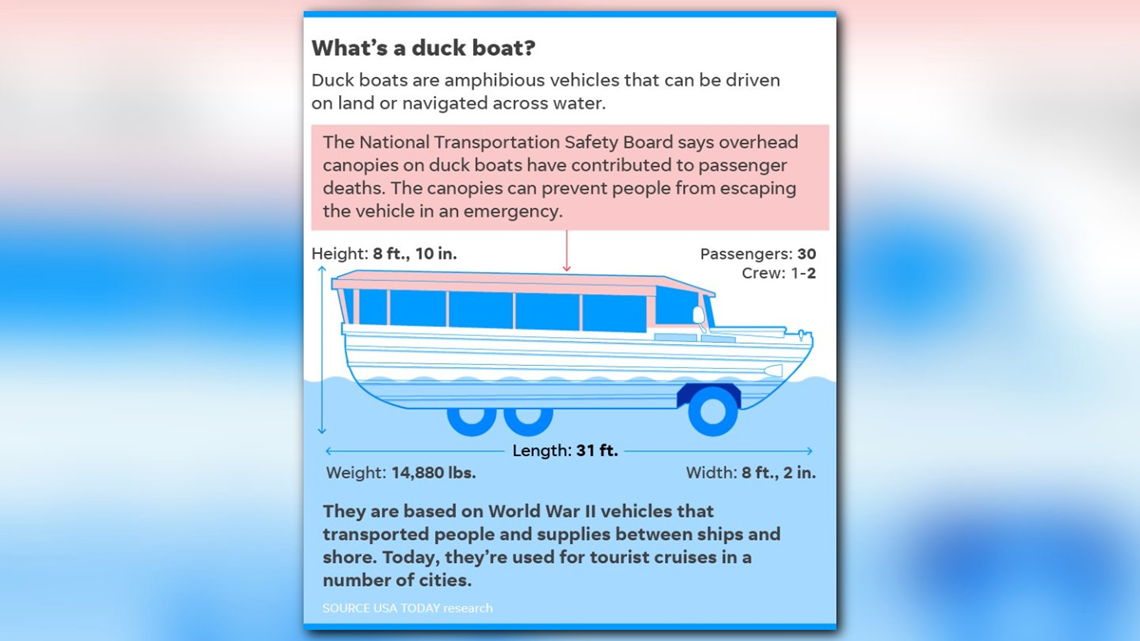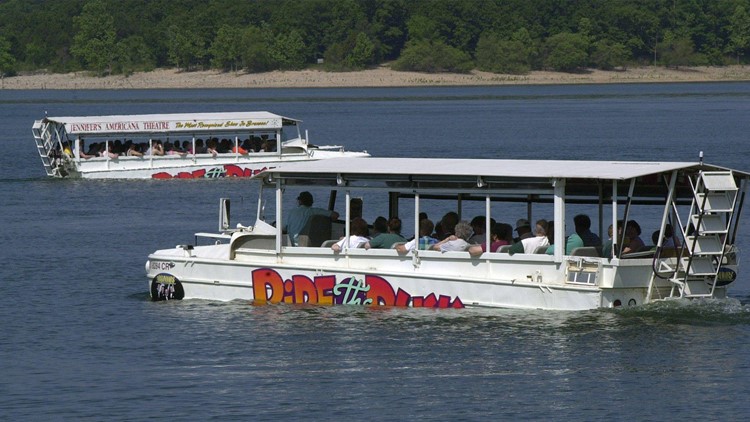Federal officials have warned tourists for nearly 20 years about the dangers posed by amphibious tour boats, which have spotty and sometimes contradictory safety regulations because they are neither entirely boat or bus.
“Duck boats are death traps on both on water and on land,” said Andrew Duffy, whose Philadelphia law firm Saltz, Mongeluzzi, Barrett & Bendesky has represented families in accidents involving the vehicles. “They should be completely outlawed.”
Seventeen people, including an unknown number of children, died Thursday after a duck boat capsized during a severe thunderstorm that churned up 5-foot waves on a lake in Branson, Missouri.
Because the boats travel on land and in water, they are regulated by the National Highway Traffic Safety Administration and the Coast Guard. The National Transportation Safety Board, which is investigating the Branson accident, has complained in the past about a lack of oversight and sometimes conflicting regulations over the vehicles.
“There is not appropriate oversight of duck boats because they fit into this hybrid of a machine,” said Duffy, who is calling for a national ban on duck boats. “They kind of fit in the cracks.”
One issue with the boats is their canopies. The Coast Guard requires passengers to wear life jackets on the water. But the NTSB recommended passengers not wear life jackets because when the vehicles sink, the life jackets carry passengers into the canopy, preventing escape.
The NTSB, which makes non-binding safety recommendations, has urged the removal of canopies from the vehicles to reduce the risk of drowning, but they often remain as on the vehicle in Branson.
The agency has also recommended the highway administration regulate the vehicles for over-the-road travel with requirements for passenger seat belts, while saying that passengers shouldn't wear seat belts while the vehicle is in the water.


Dozens of people have died in accidents involving amphibious vehicles over the past two decades:
• 13 people died when the Miss Majestic operated by Land and Lakes Tours sank May 1, 1999, on Lake Hamilton in Hot Springs, Ark. The rubber boot that provided a watertight barrier where the axle penetrated the hull failed, and the vessel sank in 7 minutes in water about 60 feet deep, the NTSB found. Seven passengers and the operator survived.
• Four people drowned when the Lady Duck sank June 23, 2002, in Canada in the Ottawa River in Gatineau, Quebec. The vehicle wasn’t watertight and sank in water about 25 feet deep near the Hull Marina, according to the Transportation Safety Board of Canada. Six passengers, the driver and tour guide escaped.
• Two people died and 26 were injured when a Ride the Ducks of Philadelphia tour vehicle sank July 7, 2010, in the Delaware River in Philadelphia. The vehicle sank in water 55 deep after colliding with a 250-foot sludge barge called The Resource towed by a 79-foot tugboat called Caribbean Sea, according to the NTSB. The accident was caused by the tugboat mate failing to keep a proper lookout while distracted by his cellphone and laptop, according to the NTSB. But the board also found that the duck-boat master contributed to the accident by failing to take appropriate actions while anchoring in an active navigation channel.
• Five bus passengers died and 71 other people were injured Sept. 24, 2015, after a collision with a Duck 6 amphibious vehicle on the Aurora bridge in Seattle. One of the Duck 6’s axles failed and led to a loss of steering and braking, the NTSB found. Ride the Ducks International modified its axle housings, drive train and other equipment, but wasn’t registered as a vehicle manufacturer, the board found.
• One woman on a scooter was killed and a passenger injured April 30, 2016, in a collision with the Penelope Pru amphibious vehicle operated by Boston Duck Tours. The amphibious vehicle overtook the scooter as both accelerated out of a stop light, the NTSB found.
The tour company Ride the Ducks settled a federal lawsuit before trial in 2012 over the Philadelphia accident by paying $15 million to the families of the two victims and splitting another $2 million among remaining passengers.
The company later shut down operations in Philadelphia because of soaring insurance costs, with a 330 percent increase in premiums.
Amphibious vehicles were sometimes used by the Army to land troops, such as during the invasion of Normandy in 1944, or modified from trucks to replicate those landing craft.
The company involved in the Missouri accident, Ride the Ducks Branson, issued a statement saying it would assist families involved and the authorities in their investigation.
“The safety of our guests and employees is our No. 1 priority,” the statement said.



